When the stork landed in Sundbyberg
This year Sweden’s largest chocolate manufacturer, Marabou, celebrates its 100th anniversary. Beginning in 1916 as a family business in the small market town of Sundbyberg, Marabou has grown into one of Sweden’s best-known brands. In addition to chocolate, Marabou has bequeathed a cultural-historical heritage comprising a progressive workplace designed by leading designers and architects in the shadow of the tall factory tower. The exhibition When the stork landed in Sundbyberg depicts the first six decades of the history of Marabou.
Early on and with an eye to the future, Marabou gave personnel welfare a central role in its corporate culture and quickly distinguished itself as one of the most modern industries of the era. Taking its Norwegian parent company A/S Freia as a model, Marabou was inspired by the idea that nature, architecture and art could serve as a counterweight to the negative effects of urbanisation and industrialisation. In keeping with the new values of the time, a progressive workplace was created in which social responsibility, art and an aesthetically designed environment were of great significance.
Hundred years have passed since the Marabou stork landed in Sundbyberg, and the stork has since flown away; the logo, featuring the eponymous bird, was revamped in the 1960s and in 1976 Marabou moved to Upplands Väsby. What remains is a small part of the sculpture collection, on view at the Marabou Park, and the stories of the people who worked in the factory, which in its heyday had almost 1,000 employees, many of whom were women, immigrants from neighbouring Finland and from rural areas in Sweden. They tell tales of an often exhausting, dangerous and monotonous work with a high turnover of staff. There are also accounts of a great community feeling and loyalty to both the company and to each other, of summer camps and staff parties. An exposé of Marabou’s history, the exhibition When the stork landed in Sundbyberg portrays the people behind the brand who worked at the factory, those who designed the facilities and their visions and the emergence of the confectionery industry in Swedish society.





